Tomato Sauce
Course: sauces
Cuisine: French
Keyword: mother sauces
Prep Time: 25 minutes minutes
Cook Time: 3 hours hours
Servings: 2.8 qt/L
Calories: 30kcal
Cost: $25
One of Five Mother Sauces
Print Recipe
Equipment
- 1 Large Dutch oven or pot
- 1 Food mill
- 1 High powdered blender optional
- 2 Rimmed baking sheets
- 1 Saucepan
- 1 Wooden spoon
- 2 large bowls
- 1 Rubber spatula
- 1 Ladle
- 1 chinois
- 6 16 ounces/450g deli containers
Ingredients
📌A new video is coming shortly!
Tomato Sauce
- 4500 g Fresh & ripe tomatoes
- 2400 g Whole peeled tomatoes (Tomaten Mulli/Bianco DiNapoli)
- 120 g Extra virgin olive oil
- 80 g Garlic crushed
- 20 g Grey salt
- 5 g Ground black pepper
- 30 g Sugar optional
- 15 g Fresh thymes sprigs
- 5 g Fresh oregano
- 3 ea. Bay leaf
Finishing Tomato Sauce
- 15 g Fresh basil
- 50 g EVOO
Blended Tomato Sauce
- 600 g Cooked tomato sauce
- 40 g Chardonnay wine
- 250 g Chicken stock Recipe
- 40 g Olive oil
- 200 g Onions chopped
- 5 g Fresh basil add more to taste
Quick Pizza Sauce
- 500 g Whole peeled tomatoes drained
- 20 g Parmigiano Reggiano grated
- 10 g Fresh basil chopped
Tomato Jelly
- 500 g Tomato water
- 20 g Gelatin 200 bloom
Tomato Eggplant Casserole
- 500 g Large eggplant cut into thick slices
- 300 g Zucchini cut into thick slices
- 200 g Bulls horn pepper Halved and seeded
- 200 g Onions quartered
- 40 g Olive oil
- 50 g Water
- 10 g Thyme, bay leave
- 40 g Garlic cloves crushed
- 200 g Tomato sauce (first batch/red)
Instructions
What Are The Best Tomatoes For Sauce?
- Fresh and ripe tomatoes are a prime example of an ingredient that can take your cooking to the next level. One technique that really allows the flavors of fresh and ripe tomatoes to shine is concentrating them. To concentrate the flavors of fresh tomatoes, start by selecting the best quality tomatoes you can find. Tomatoes are best picked from mid-July through the end of August. Look for beefsteak tomatoes, Roma tomatoes or grape tomatoes that are plump, firm, and deeply colored, as these are signs of ripeness and flavor. Tomato sauce can be made using a mix of fresh tomatoes and best canned tomatoes from Italy.

What Makes Red Tomato Sauce Turn Orange in Color?
- When cooking with tomatoes, it's essential to keep their vibrant red color from turning orange due to oxidation when exposed to air. To preserve the original hue, consider passing the tomatoes through a food mill before or after cooking. This technique helps maintain the bright red appearance of the tomatoes in your dishes. For a smooth and refined texture, the tomato sauce can be blended and sieved. This process helps remove any seeds or skin, resulting in a velvety sauce but will change the color. Great for soups, meat balls, fish, and cooked vegetables but not for pizzas.

- Wash tomatoes. Prepare your tomatoes by removing the core and slicing them in half.
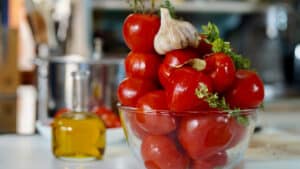
- Place the tomato halves cut side up on 2 rimmed baking sheets without parchment paper. Drizzle olive oil, and season them with salt, pepper, sugar, herbs and crushed garlic.
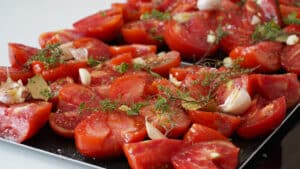
Roasting Tomatoes
- Preheat fan oven to 400ºF/225ºC. Roast tomatoes for about an hour (carefully remove excess water released during cooking and save the liquid). Peel off tomatoes. Discard garlic peelings and herbs. Place roasted tomatoes flesh and garlic in a large bowl. Scrape out any bits left on the baking sheets and add it to the mixture.
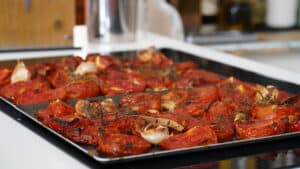
Finishing Tomato Sauce
- Pass roasted tomatoes and garlic through the food mill. Meanwhile, in the saucepan heat up olive oil and throw in fresh basil. Cook a couple of minutes until fragrant. Add to the tomato sauce, and cook for 2 hours on medium heat stirring every so often. Readjust seasoning with salt, pepper and sugar to taste. Let cool the sauce on the stove overnight.

Blended Tomato Sauce
- Sweat onions in olive oil on medium heat for 10 minutes without giving any color. Deglaze with wine and reduce to dry.

- Add chicken stock or use the tomato water that has been saved during roasting. Add tomato sauce and cook for approximately 15 minutes.

- Blend tomato sauce and pass through the chinois. Cook again for a few minutes and readjust seasoning if needed.
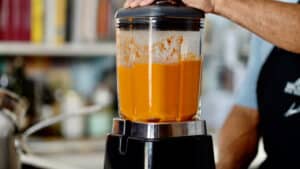
Storage
- Refrigerate tomato sauce for up to 4 days or store in the freezer for six months in sealed deli containers or vacuum-sealed. Thaw in the refrigerator overnight before using.
Canning Tomato Sauce
- Prepare a large stockpot with a canning rack and jars. Fill jars with water, cover and bring to boil. Carefully, remove and empty jars using a canning jar lifter. Arrange jars over countertop lined with a kitchen towel. Fill up jar according canning instructions and clean up any sauce residue remaining on the jar rim using clean paper towel moisturized with hot water. Put lids on (no need to boil prior using) and tight up with the ring. Lids can be used once while rings many times. Rings need to be tight but certainly not cranked on as hard as possible. Place filled jars in can lifter and lower jars into water. Make sure water covers jars by 1 to 2-inch/5cm. Bring to a boil, cover and cook for 40 minutes on a slow boil. Lift canning rack, and carefully transfer jars on cutting board lined with a kitchen towel. Let cool 18 hours undisturbed. Label and date lids and store for up to 12 months.
Tomato Jelly
- Soak gelatin in cold water to soften, and drain. Season tomato water with salt to taste. Bring the saved tomato water to a boil. Remove from the heat, and whisk in the soften gelatin. Line a rimmed container with an opened freezer bag. Pour in the hot tomato jelly and let cool – then place in the refrigerator overnight to set. Cut into desired shapes. Tomato jelly is great for Bloody Marys, salads, fish or paired with Pâté en Croute etc…
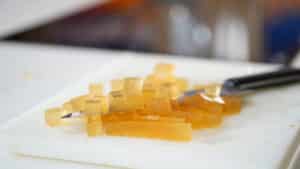
Quick Pizza Sauce
- Pass drained tomatoes through the food mill. Add the herbs, cheese and season with salt, pepper and sugar. Add more parmigiano and some of the saved tomato juice to the sauce until desired consistency is reached.

Tomato Eggplant Casserole
- In an oven proof sautoir, heat up olive oil and sear eggplant slices on both sides on medium-high heat. Toss in remaining ingredients, add water and cook on high heat for 5 minutes. Season with salt and pepper and pop the pan in the oven, and roast for 40 minutes at 400ºF/200ºC flipping veggies twice during cooking. Then toss in tomato sauce and bake for an additional 25 minutes. For a better caramelizing effect, increase oven temp to 425ºF/220ºF. Enjoy!
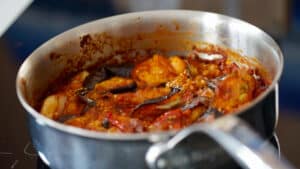
Nutrition
Serving: 100g | Calories: 30kcal


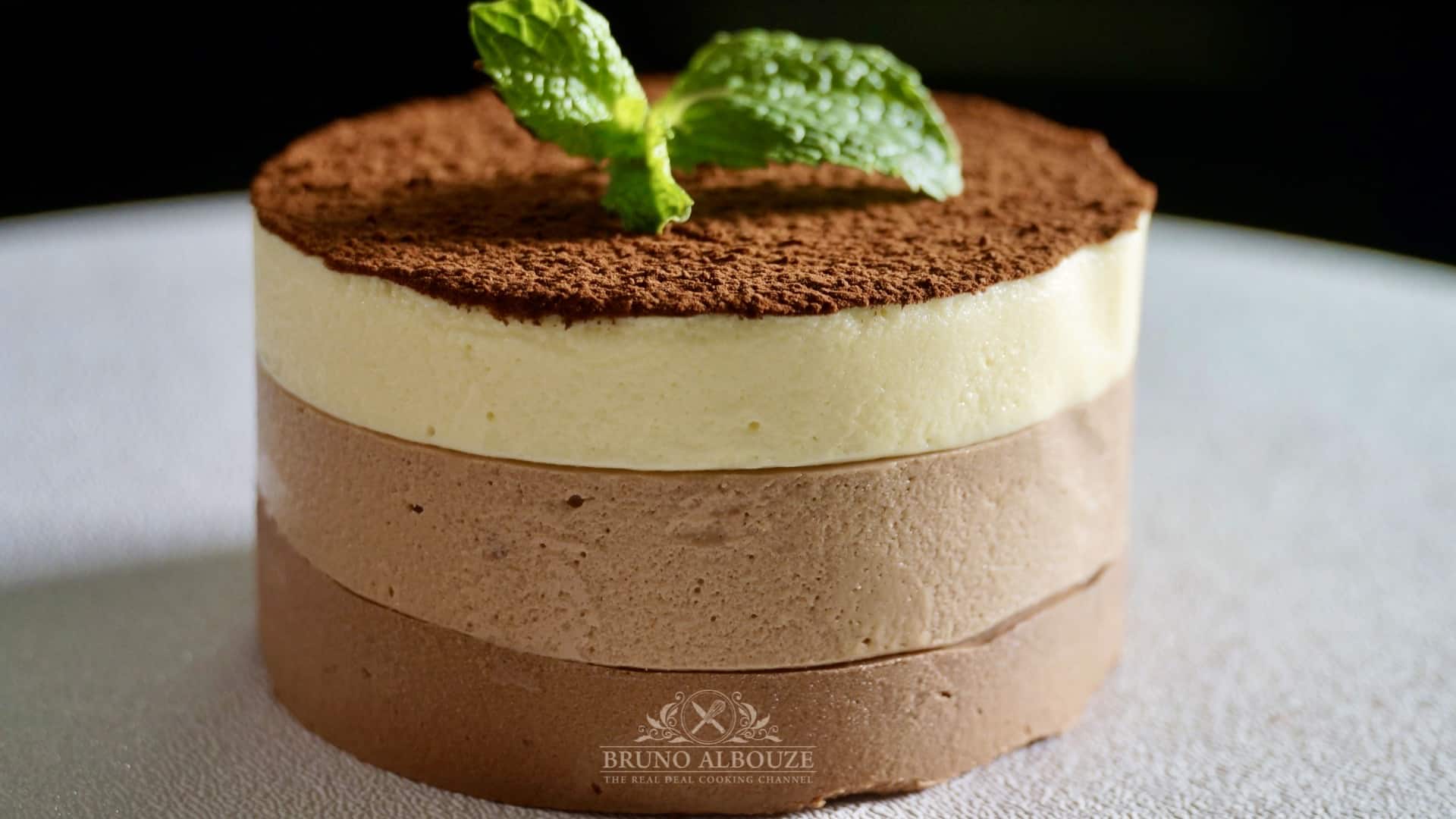

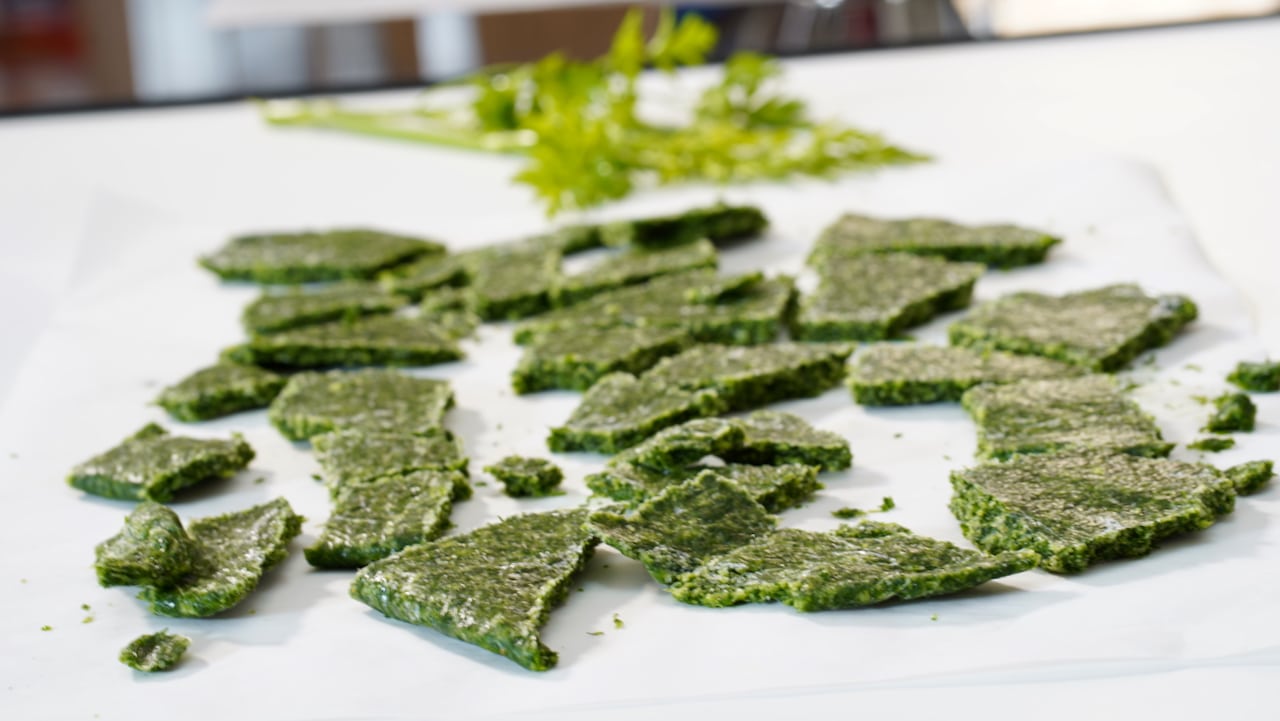


2 thoughts on “Tomato Sauce”
Bonjour Bruno,
Je voudrais savoir ce qu’il vaut mieux avoir comme pierre à pizza de 2 cm d’épaisseur : de la pierre de lave ou de la cordiérite ? Est-ce que c’est de l’acier ? Est-ce qu’il y a un entretien spécial ?
Par ailleurs j’ai trouvé une lame à bascule de 52 cm chez Nisbets qui devrait arriver aujourd’hui. Celle de Gozney est bien jolie mais plus disponible… Sinon celles proposées en général mesurent 35 cm ce qui me semble un peu court ?
Je serais contente d’avoir votre avis. Belle journée
Bonjour Agnès,
Pour la pierre a pizza ou pain, une pierre de lave rectangle me semble plus approprié (voir les revues a propos). Bien la chauffer au four pendant 30 minutes au moins avant d’y faire glisser la pizza ou pain. Je ne sais pas en revanche, se qu’est une lame a bascule.. 🤨